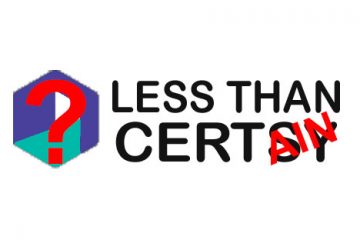Procedure and Form Numbering
Who says we should number procedures and forms? It eludes us, but we would like to give whoever it is a kick in the pants. Almost every Company that already has an in-house management system or one they outsourced has the whole thing numbered from start to end and even we are guilty of it.
When numbering makes sense
We number the procedures that make up the integrated section of management systems we develop. There’s a good reason why we number them – they’re fixed – they won’t change. We may update them , but those documents will most likely be there from the beginning to the end of the life of the management system. How can we be so sure? Because they are titles for generic elements that are in most management systems and they aren’t focussed on one particular standard.
The Good
The value of numbering a document is that it can:
• allow you to quickly find a document in a list
• be easily referred to without repeating a long title
• help organise electronic files in folders into your preferred order
So based on this why would anyone avoid numbering their documents?
The Bad
Well those were the positives, now the negatives. Numbered procedures and forms can be:
• restrictive in that trying to insert a document into a specific location in the list becomes awkward,
• confusing to users when a form number is missing from a sequence,
• difficult to decipher which document is being referred to for those unfamiliar with the document numbers,
• easily mistyped – a single digit error means that you are referred to completely the wrong document.
Hierarchy of thought
So we’ve identified the good and the bad of numbering. You may now think your decision is easier, but we want to pick apart the positives a bit further. If you are looking for a document, what’s the hierarchy of thought? People first think they need a document for a specific purpose such incident recording and then try to recall the document number. If the key piece of information is the purpose of the form why shift focus to a document number?
Ok so picking it apart a bit more; would anyone believe it good practice to only refer to a document number in text rather than quoting the title too? We think not. As we’ve already said it’s too easy to make a mistake if you only quote a document number. And even if you get it right can you imagine what a nightmare a document would be if it read something like this “Using P65 carry out the TM7 and record it on F12 ensuring compliance with P67 at all times”. Ridiculous! Users would have to sit there with the document index open to make any sense of it. So again the name of the document is critical, the number much less so.
Grouping
However you arrange your documents they should be in groupings (such as folders). And they should not rely solely on numbering or their names to be located. The more documents you have, the more levels of groups you need.
Numbering, but not as you know it
When we design a Management System we number operational procedures. These are the procedures that are specific to say Environmental Management, but trust we prefer a less traditional numbering. We like to give them all the same number. Yep, you heard us right. We might, for instance, give all the quality specific procedures that sit under top level documents the same number. And all the safety procedures another number. The environmental procedures would get their own number too. Does that sound weird? Let’s explore the reasoning behind this.
Providing the same number for groups of documents means that the focus is on the name of the document (which is really what people think of when they go looking for a document), the number merely identifies what part of the system the document relates to and allows the quick and easy grouping of documents. We like to put these documents into their own container which is similarly numbered and has an appropriate description. Then we aim to limit the number of documents with the same document number in each container to around twelve. If you can get to the right folder or document number for a group of documents then identifying your document is easy. It also means there are fewer numbers to remember so there’s a better chance of memorising them.
Numbering persists
If you insist on numbering your documents and avoid groupings then make sure the numbering system is logical. Ensure people can have a good stab at guessing at least the start of the document number. For instance a Safety Form could start SF whereas a Safety procedure could start SP and a Quality Procedure start QP.
Naming in the absence of numbering
If you are not using document numbers then when you name a document or a file think about its name carefully. Computers tend to order files alphabetically. So with care you can ensure the right documents are side by side in a file listing. For instance don’t use the names Audit Report and Schedule of Audits. Rather use Audit Report and Audit Schedule so that these related documents appear next to each other the folder.
Never expect users to rely solely on the document numbers to locate them. And make sure you provide and use search tools where possible. Ensure you teach staff how to use whatever search facilities you have in place. These will be critical to the success of your system and should be part of Management System training.


